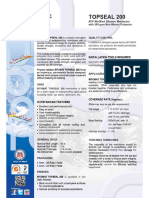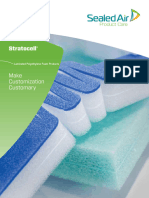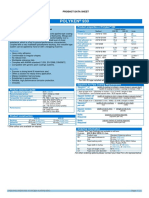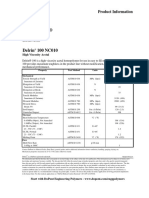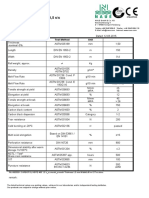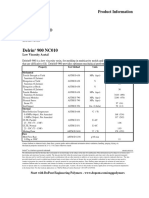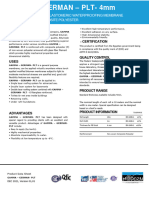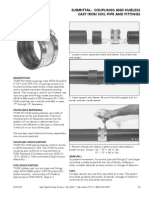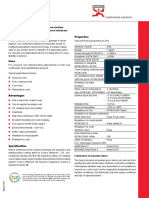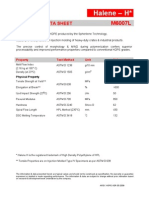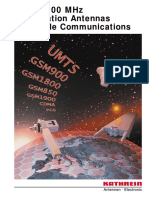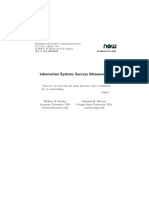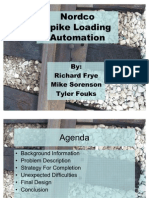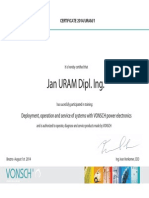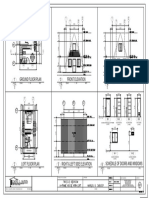Metazeal
Metazeal
Uploaded by
hernie vergel de diosCopyright:
Available Formats
Metazeal
Metazeal
Uploaded by
hernie vergel de diosOriginal Description:
Copyright
Available Formats
Share this document
Did you find this document useful?
Is this content inappropriate?
Copyright:
Available Formats
Metazeal
Metazeal
Uploaded by
hernie vergel de diosCopyright:
Available Formats
1.
Metazeal®
Metazeal a UV stable, pre-formed closed-cell, low-density PE (polyethylene) foam joint seal. The material is typically used as an expansion
joint seal or gasket in bridge decks, commercial buildings, parking decks, water treatment facilities, and other industrial applications.
Metazeal has a higher maximum operating temperature, 212°F when compared to our other pre-formed closed cell foam solutions. When
installed within the Ceva Joint Systems, this material acts as a water tight, seismic expansion joint seal.
Additional features include applications in hydrostatic environments. This material can be installed in ponding/standing water. Metazeal
material is safe for use in potable and processed water applications.
Metazeal meets ADA criteria for ground and floor surfaces as stated in the rules and regulations section of the Federal Register Volume 58
no.144, US Access Board.
FEATURES BENEFITS TECHNICAL DATA
Dynamic movement range Properties Test Method Typical Properties
Seismic expansion joint
of -50%, +25% & ±50% Compression ASTM D3575
seal 2 hr Recovery 9% Set
shear Set Suffix B
Can be used in below ASTM D3575
Waterproof Elongation 152% - 245%
grade applications Suffix T
Withstand up to 70 ft. of Ideal for stage construction ASTM D3575
head pressure or segmental repairs Density 1.8 – 2.5 lbs/ft³ avg.
Suffix W
Maximum operating Can be used in high heat
Water ASTM 3575
temperature of 212°F applications .03 lbs/ft² avg.
Absorption Suffix L
No anchoring system
ASTM G154 No chalking, flaking,
required, reduced
Ease of installation 3000 Hrs blistering, checking &
installation time and labor Weatherability
cracking
costs
Field directional changes & Up to 3 hours of passive HH-F-341a No Degradation
heat welds fire protection ASTM D3575 110 – 130 psi
Tensile
Suffix T (758 – 896 KPa)
USES ASTM D624
Tear 16 lbs/in
Applications ASTM D3575
Resistance
• Expansion joints Suffix G
• Seismic joints
Compression
• Gaskets ASTM D3575 9
Deflection 25%
• Seismic retrofit
• Cast-in-place joints Thermal ASTM D3575
5.9% Max
Locations Stability Suffix S
• Bridges/Highways/Tunnels/Airport Runways
Toxicity ISO-10993.5 Pas (not cytotoxic)
• Commercial Buildings
• Water Treatment Facilities Meets ASTM 1056 Type 2, Class B, Grade 2
• Tanks/Pools & AASHTO T-42-84 Modified
• Industrial Facilities
• Parking Garages
Substrate
• Concrete
• Elastomeric concrete
• Steel
• Wood
• Most construction materials
Revision 04/11/12 Page 1 of 3
1.
MOVEMENT CAPABILITY
Storage: Joint material shall be stored in an area that maintains
Metazeal is capable of functioning within 50% compression and temperature between 50°F (10°C) and 90°F (32°C).
25% tension movement range. Metazeal can handle up to 50% ±
total horizontal or vertical shear movement. INSTALLATION PROCEDURES
Surface Preparation: Brush blast all concrete surfaces in direct
SIZING GUIDELINES contact with joint seal. Concrete surfaces should be free of all
Metazeal is typically sized 25% larger than the joint opening. The contaminants and latent build up. Blow dirt or debris from the joint
amount of compression will vary due to seasonality, temperature openings and joint surfaces with oil free compressed air. Steel
and designed movement of the joint. Please contact your sales surfaces must be cleaned to SSPC 10 or better. Ensure that all
representative for assistance. moisture is removed from steel surfaces prior to applying the
ENGINEERED SURFACE PROTECTION bonding agent. Use of a propane wand is acceptable.
The joint material shall have E.S.P. (Engineered Surface Seal Installation: The manufacturer’s published installation
Protection) grooves along the bond surfaces at a distance of no procedures shall be followed at all times. Mask the areas adjacent
less than ¼” and no more than ½” a part (6mm – 13mm). The to the joint opening. Use approximately 12” (300mm) of plastic
grooves are approximately 1/8” deep x 1/8” (3mm x 3 mm) wide sheeting and tape along edges to keep the surrounding areas
and run the entire length of the joint, increasing the bond surface clean. Be sure that the tape does not actually go into the joint
for enhanced bond performance. opening but back approximately 1/8” (3mm) from the joint edge.
PERFORMANCE INSTALLATION ENHANCEMENT Lay out joint material next to its joint opening to check for
For joint openings exceeding 3 inches in width and depth, appropriate length and width. Heat welds and other directional
Performance Installation Enhancement or P.I.E. is changes should be cut and made. All welds should be allowed to
recommended. When P.I.E. is added to the joint material, an cool before mixing the adhesive.
additional inch of depth is added for beveling. This bevel creates
Begin mixing the epoxy adhesive following the manufacturer’s
a natural trapezoidal shaped product that is easier to install.
specified mixing procedures and start at one end or at an
JOINT MATERIAL LIMITATIONS intersection or corner. Apply the epoxy adhesive to both sides
Directional Changes: All directional changes in joint material of the concrete substrate surfaces.
should be complete by heat welding. This is done by placing the
joint material ends against a Teflon coated heating iron at 350°F Apply enough adhesive to coat the substrate to an approximate
thickness of 40 mils (1mm). Apply the epoxy bonder on both
(176°C) for 10 – 20 seconds. The ends are then placed firmly
surfaces working in the direction ahead of the joint material, not
together and fusion bonded. If heat welding is not an option:
more than 20’ (6m) ahead.
Vertical turns - the maximum angle the joint material can sustain
without heat welding is 115°. Horizontal turns – the maximum Apply the epoxy adhesive to both sides of the joint material.
angle the joint material can sustain without heat welding is 135°. Apply enough to coat and fill the grooves on the joint material,
Heat welds will add to the aesthetics of an installation and are approximately 40 mils (1mm) thick. Install the coated material at
suggested for horizontal 90° turns. the curb, intersection, or corner, where the epoxy was initially
applied on the substrate.
Joint Variations: If a joint opening is not uniform, please contact
your local sales representative for assistance. The joint material should be installed 1/8” (3mm) below the joint
edge and should not protrude above the joint edge.
Skews: Metazeal does not have skew limitations
Continue in the same direction as the epoxy was initially
Operational Temperature Range: The physical and chemical
applied. DO NOT push at an angle or pull the material, as this
properties of the joint material do not alter significantly within the
will stretch the material and is unacceptable.
recommended temperature range of -94°F to 212°F (-70°C to
71°C). Clean the epoxy from the surface of the material as soon as it is
recessed to the desired depth. DO NOT allow the epoxy to
Maximum Joint Opening: When the expansion joint is subjected to
cure before removing it. Use a clean trowel or putty knife to
pedestrian or vehicular traffic, the following limitation
remove excess epoxy adhesive.
recommendations apply:
Once the joint is installed and cleaned, remove the tape from
Vehicular Traffic: Maximum Joint Opening of 4” without a cover
the joint edges before the epoxy cures.
plate.
Pedestrian Traffic: Maximum Joint Opening of 4” without a cover
plate.
Revision 04/11/12 Page 2 of 3
1.
PACKAGING
Allow the bonder to set, approximately 20 minutes, at 77°F
Metazeal is custom fabricated to order. Please contact your
(25°C), before traffic is allowed onto the joint. Slightly longer time
is required during cooler weather. local sales representative for size and availability.
Also available in sheets.
When a continuous joint cannot be finished, the epoxy bonder on
the substrate and on the joint material must end evenly. Install the MANUFACTURER’S CERTIFICATIONS
joint past the epoxied surface at least 6 to 12 inches (150-300mm) Available upon request.
dry, or without epoxy. This can be pulled out later to be re-welded MANUFACTURING TOLERANCES
and the installation continued.
The preformed joint material shall be the thickness and width
described in the contract plans within a depth tolerance of
+/-5% and a width tolerance of +/- 2%.
Contact Chase Construction Products
Global Operations Center
295 University Avenue Toll Free (US only): 800-323-4182
Westwood, MA 02090 Tel: 781-332-0700
USA Fax: 781-332-0702
www.chasecorp.com Email: info@chasecorp.com
Warranty & Limitation of Seller’s Liability
The information contained herein is provided for product selection only, and is not to be considered as a specification or performance data. Chase Construction Products (a division of Chase
Corporation) warrants the product for a period of one (1) year from the date of initial shipment to the initial purchaser, that the products meet the parameters listed on the applicable Technical Data
Sheet. Chase makes no warranty of any kind, expressed or implied, including that of merchantability, other than that products conform to Chase’s current quality control standards at time of
manufacture. If breach of warranty is established, the buyer’s exclusive remedy shall be repayment of purchase price of the non-conforming product to replace the non-conforming product. The
buyer expressly waives any claim to additional damages, including without limitation, incidental or consequential damages. Specific conditions of sale and Chase’s limited warranty are set out in
detail in Chase Corporation Terms and Conditions of Sale.
Revision 04/11/12 Page 3 of 3
You might also like
- Catálogo de Peças 5303 e 5403 ImportadoDocument340 pagesCatálogo de Peças 5303 e 5403 ImportadoMAGHACYA BARBOSA50% (2)
- Compatible Tubing Ts6Document28 pagesCompatible Tubing Ts6Defi Jodi Permana0% (1)
- Topseal 200Document2 pagesTopseal 200faiyasNo ratings yet
- Stratocell Brochure D-148 10-2017Document4 pagesStratocell Brochure D-148 10-2017Carlos GamioNo ratings yet
- Canusa GTS 80Document2 pagesCanusa GTS 80ZainudinNo ratings yet
- Polyken 930: Product Data SheetDocument2 pagesPolyken 930: Product Data SheetEdwin Bustamante Cabrera100% (1)
- Polycarbonate Data SheetDocument1 pagePolycarbonate Data SheetJoseph Cloyd Lamberte100% (1)
- Dow Elite 5400G TDSDocument2 pagesDow Elite 5400G TDSAli RazuNo ratings yet
- Polyken 930: Product Data SheetDocument2 pagesPolyken 930: Product Data SheetAgustina De Winne100% (1)
- PDS Polyken 980 955 V5 Sep20 Aarps 0285Document2 pagesPDS Polyken 980 955 V5 Sep20 Aarps 0285Andrea Pamela León AlgarañazNo ratings yet
- Tech Data Sheet IMPAXX™ 700 Energy Absorbing Foam: Product InformationDocument2 pagesTech Data Sheet IMPAXX™ 700 Energy Absorbing Foam: Product InformationAnonymous KjrLUwYSNo ratings yet
- Delrin100 NC10Document2 pagesDelrin100 NC10avinashchauhan2695No ratings yet
- Geomembrana Hdpe 1.5 AmpDocument1 pageGeomembrana Hdpe 1.5 AmpRicardo SanchezNo ratings yet
- PDS Polyken 930 NOV13 V2 AARPS 0543Document2 pagesPDS Polyken 930 NOV13 V2 AARPS 0543moch ardiansyahNo ratings yet
- MOLYKOTE 4 Electrical Insulating Compound 10-1187O-01Document2 pagesMOLYKOTE 4 Electrical Insulating Compound 10-1187O-01marlunnNo ratings yet
- GDW Dual Wall TubingDocument1 pageGDW Dual Wall TubingrupinderNo ratings yet
- Product Technical Sheet - R series 050715Document6 pagesProduct Technical Sheet - R series 050715Kmilo VinaTea ChavezNo ratings yet
- Torch SealDocument2 pagesTorch Sealmk779900mkNo ratings yet
- Kpic RP2400 - Spec SheetDocument1 pageKpic RP2400 - Spec Sheetcongvan95No ratings yet
- BR 352 TDSDocument2 pagesBR 352 TDSJerry Mar LucenaNo ratings yet
- DS 40 Full SubmittalDocument50 pagesDS 40 Full Submittalahmed100% (1)
- ASTM FL7100U Eng 240223Document1 pageASTM FL7100U Eng 240223MERVENo ratings yet
- Polyflame Garden - I & IIDocument2 pagesPolyflame Garden - I & IIAbdul Jaleel MohammedNo ratings yet
- Fluteck P7500 CA v01.19Document2 pagesFluteck P7500 CA v01.19fprovitaliNo ratings yet
- POM Delrin 900 HFDocument2 pagesPOM Delrin 900 HFcountzeroaslNo ratings yet
- Ethafoam Nova: Performance FoamsDocument2 pagesEthafoam Nova: Performance FoamsMina MagdyNo ratings yet
- 81 Imi ImpermitDocument2 pages81 Imi ImpermitEngr KamalNo ratings yet
- Pds Covalence Htlp80 v3 Dec16 Aarps 0199Document2 pagesPds Covalence Htlp80 v3 Dec16 Aarps 0199Benaknaik S GajannavarNo ratings yet
- Technical Data: Carbofol HDPE 406 1,0 S/s Smooth / Smooth OITDocument1 pageTechnical Data: Carbofol HDPE 406 1,0 S/s Smooth / Smooth OITAlex Lie100% (1)
- PDS CSG-100 (ENG) - s-11521Document1 pagePDS CSG-100 (ENG) - s-11521huongktbNo ratings yet
- S1005 TairiproDocument1 pageS1005 TairiproJacquelin DelgadoNo ratings yet
- PDS Polyken 932 V3 Jan19 Aarps 0545Document2 pagesPDS Polyken 932 V3 Jan19 Aarps 0545Hector MejiaNo ratings yet
- Controlled Volatility RTV Ablative Silicone: Description ApplicationDocument3 pagesControlled Volatility RTV Ablative Silicone: Description ApplicationLU CHUNHUINo ratings yet
- Poly FlameDocument2 pagesPoly Flamemk779900mkNo ratings yet
- GAMMA-GERMAN PLT-PE-4mmDocument2 pagesGAMMA-GERMAN PLT-PE-4mmEgyp XsNo ratings yet
- H6105JUDocument1 pageH6105JUhunghiepvanNo ratings yet
- Pds Tial m80Document2 pagesPds Tial m80Yan FerizalNo ratings yet
- Pghsaw33 01BKDocument2 pagesPghsaw33 01BKRanjan GnanaoliNo ratings yet
- PanelMax Corner DuctDocument4 pagesPanelMax Corner DuctHerman [BSI]No ratings yet
- Pghsim33 01NCDocument2 pagesPghsim33 01NCRanjan GnanaoliNo ratings yet
- DataSheet 06052024062953Document2 pagesDataSheet 06052024062953Preetpal SinghNo ratings yet
- Styroflex 2G66: Styrene Butadiene Copolymer (SBC)Document3 pagesStyroflex 2G66: Styrene Butadiene Copolymer (SBC)Ronaldo CamargoNo ratings yet
- Pds Na Gts65Document2 pagesPds Na Gts65Yan FerizalNo ratings yet
- Submittal For Cast Iron PipesDocument2 pagesSubmittal For Cast Iron PipesAli EuropeNo ratings yet
- PP Formosa Tairipro K7005Document1 pagePP Formosa Tairipro K7005fguastaNo ratings yet
- PDS Polyken 980 955Document2 pagesPDS Polyken 980 955David100% (1)
- Imperseal 7000Xl: Salient FeaturesDocument2 pagesImperseal 7000Xl: Salient FeaturesJeff GajeNo ratings yet
- Nitoproof 725: Description PropertiesDocument3 pagesNitoproof 725: Description PropertiesNikhil BhatiaNo ratings yet
- HD2200JP Technical Data Sheet 20240208170555Document1 pageHD2200JP Technical Data Sheet 20240208170555phanplastic299No ratings yet
- M6007LDocument1 pageM6007LempacNo ratings yet
- Lldpe Slip 7810dDocument1 pageLldpe Slip 7810dakshayNo ratings yet
- Covalence HTLP80: Product Data SheetDocument3 pagesCovalence HTLP80: Product Data SheetJuan Carlos Contreras CherresNo ratings yet
- LL7410D1Document1 pageLL7410D1Nitin MaheshwariNo ratings yet
- TDS-Proofex-Torchseal-4PI-India4 (1)Document2 pagesTDS-Proofex-Torchseal-4PI-India4 (1)Aarish KhanNo ratings yet
- DOWSIL™ 795 Structural Glazing Sealant Technical Data SheetDocument5 pagesDOWSIL™ 795 Structural Glazing Sealant Technical Data SheetTrung Nguyễn NgọcNo ratings yet
- DTM Acrylic Coating: Protective & Marine CoatingsDocument4 pagesDTM Acrylic Coating: Protective & Marine CoatingsAna CabreraNo ratings yet
- 9765 Rubber Hydraulic Seals and WaterstopsDocument20 pages9765 Rubber Hydraulic Seals and WaterstopsStephenNo ratings yet
- RT-duroid 6202 Laminate Data SheetDocument2 pagesRT-duroid 6202 Laminate Data SheetAditya Bonnerjee 21BEC0384No ratings yet
- PDS Polyken 980 955 V3 Jan19 Aarps 0285Document2 pagesPDS Polyken 980 955 V3 Jan19 Aarps 0285Irawan FajarNo ratings yet
- Technical Data Sheet: Premium AW Hydraulic FluidDocument1 pageTechnical Data Sheet: Premium AW Hydraulic FluidDiegoNo ratings yet
- Innoplus (GC Marketing) LL7835ADocument1 pageInnoplus (GC Marketing) LL7835AOscar Tan IIINo ratings yet
- For Multidisciplinary CAE Pre-& Post-Processing: Software Systems PioneeringDocument8 pagesFor Multidisciplinary CAE Pre-& Post-Processing: Software Systems PioneeringnawramiNo ratings yet
- El. Stability TesterDocument23 pagesEl. Stability Testergplese0No ratings yet
- Tabla Tabulación de Datos de DifusiónDocument1 pageTabla Tabulación de Datos de DifusiónPuede ser PaNo ratings yet
- Nmi R 49-1Document49 pagesNmi R 49-1megacobNo ratings yet
- 2009 Kamaraju - Electrical Power Distribution systems-McGraw Hill-131-154Document24 pages2009 Kamaraju - Electrical Power Distribution systems-McGraw Hill-131-154C071Ridho Setiawan TuitantoNo ratings yet
- Case Study and Team Building FinalDocument64 pagesCase Study and Team Building Finalrowlingsndiko15No ratings yet
- Men: 0 Duct: 0 Units En: Expansion Joint - Shell - Xls.Xlsexp JT (Type 3) 22Document1 pageMen: 0 Duct: 0 Units En: Expansion Joint - Shell - Xls.Xlsexp JT (Type 3) 22NTRNo ratings yet
- CN Chap04 - Load TracingDocument25 pagesCN Chap04 - Load TracinggeorgegimNo ratings yet
- 8.21 The Physics of Energy: Mit OpencoursewareDocument34 pages8.21 The Physics of Energy: Mit OpencoursewareywoodyNo ratings yet
- Testing of RelaysDocument9 pagesTesting of RelaysAnimesh Jain100% (1)
- Kathrein 2002 PDFDocument179 pagesKathrein 2002 PDFvuldaroq0% (1)
- Full Text DELONE MCLEAN PDFDocument119 pagesFull Text DELONE MCLEAN PDFrevita100% (1)
- Shop Drawing Checklist Form 2Document2 pagesShop Drawing Checklist Form 2Ahmad Mahmoud AlshataratNo ratings yet
- Merge Replication Performance ImprovementDocument17 pagesMerge Replication Performance ImprovementMir Farhan Ali AbediNo ratings yet
- Final Presentation NordcoDocument18 pagesFinal Presentation Nordcosorens23No ratings yet
- HVAC Design For Pharmaceutical FacilitiesDocument57 pagesHVAC Design For Pharmaceutical FacilitiesShams MInhaz Monzur100% (4)
- Data 1 Boiler Efficiency by Indirect Method Coal Fired BoilerDocument14 pagesData 1 Boiler Efficiency by Indirect Method Coal Fired BoilerM Ziaul ArifNo ratings yet
- VONSCH Certificate For URAM SYSTEM EmployeesDocument10 pagesVONSCH Certificate For URAM SYSTEM EmployeesJakub VonkomerNo ratings yet
- UcD FD1K Full Discrete Class D Amplifir Ver.3a MODSDocument1 pageUcD FD1K Full Discrete Class D Amplifir Ver.3a MODSAndrew LebonNo ratings yet
- Steam Turbine Hydraulic Servomotor For Description Main and Reheat Control ValvesDocument2 pagesSteam Turbine Hydraulic Servomotor For Description Main and Reheat Control Valvesparthibanemails5779100% (1)
- Mckissick Oilfield Servicing BlocksDocument1 pageMckissick Oilfield Servicing Blocksvikrant911No ratings yet
- AptitudeDocument61 pagesAptitudeAmritanjan Das33% (3)
- Frost Protected Shallow Foundations FINALDocument4 pagesFrost Protected Shallow Foundations FINALDarren Winslow0% (1)
- SHW Series 1600 Piling and Embedded Retaining Walls - November 2005Document49 pagesSHW Series 1600 Piling and Embedded Retaining Walls - November 2005José Luis Rodríguez SánchezNo ratings yet
- IEEE STD 548-1984 Standard Criteria and Guidelines For The Laboratory Measurement and Reporting of Fly Ash Resistiviy PDFDocument30 pagesIEEE STD 548-1984 Standard Criteria and Guidelines For The Laboratory Measurement and Reporting of Fly Ash Resistiviy PDFyanuar yudhiNo ratings yet
- RF Unit and Topology Management SRAN8 0 Draft B PDFDocument91 pagesRF Unit and Topology Management SRAN8 0 Draft B PDFEjaz BashirNo ratings yet
- A-Frame House With Loft-ModelDocument1 pageA-Frame House With Loft-ModelEdmond BautistaNo ratings yet


